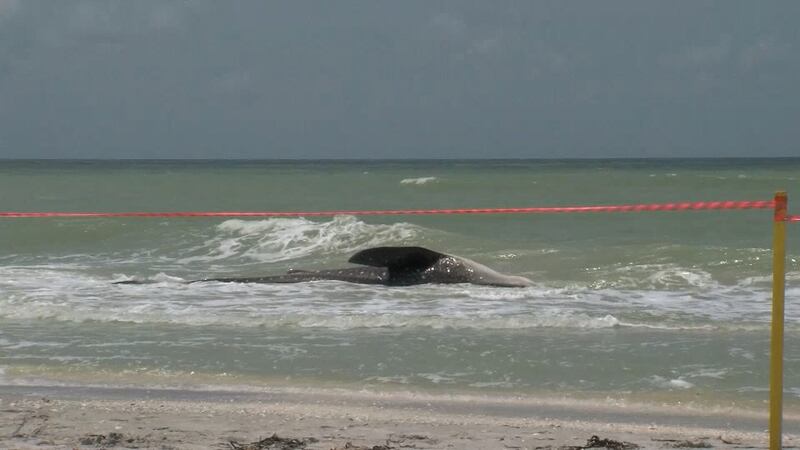SANIBEL ISLAND, Fla. — The carcass of a 26-foot-long adult whale shark washed up on Sanibel Island, Florida, on Sunday morning.
It was buried on the beach that same day after Florida Fish & Wildlife Conservation Commission staffers examined and measured the fish – and took tissue samples.
“These samples will be analyzed in our St. Petersburg laboratory, which is the headquarters for studying marine fisheries health,” said Michelle Kerr, an FWC spokeswoman.
The whale shark was male, hadn’t quite reached adulthood.
Marine biologists from the Bailey-Matthews National Shell Museum were on the beach where the shark came ashore.
The shark's cause of death was not immediately known, but Shell Museum marine biologist Rebecca Mensch said the shark showed little signs of decay and likely died Saturday night or Sunday morning.
The shore where the shark was found is littered with dead fish as well, causing many to speculate that red tide may have been the cause of the animal's death. A red tide is an increase in concentration of the microscopic algae K. brevis, which releases toxic chemicals that kill marine organisms and can turn the water red.
"The research is still ongoing whether or not these animals are susceptible to red tide or, if they are, how sensitive are they," Mensch said. "So, that's not something one way or the other that you can say it was red tide."
A tissue sample and toxicology test that can take anywhere from days to weeks to provide results might give the biologists answers as to whether red tide affected the shark, she said.
The museum has been working with Mote Marine Laboratory & Aquarium in Sarasota, Fla., to determine if the shark was one of the animals Mote tracks. But when a team of three marine biologists looked over the shark for tagging, it did not appear to be one of Mote's sharks.
The shark drew a crowd of dozens of beachgoers, many of whom were snapping pictures and taking video, in awe of the giant animal.
"You’ve been to like aquariums and stuff and you’re like ‘This is the wildlife’ but seeing it up close and in nature it’s shocking," said Lily Miller, a 16-year-old from Cleveland, Ohio, who was visiting Sanibel for the first time with her family. "Especially seeing a huge dead shark. It breaks my heart and it’s not something you ever expect to see, especially when you’re out in the (gulf)."
While whale sharks aren't something you might expect to see on Southwest Florida beaches, they are actually quite common on the other side of the coast, near Cozumel, Mexico, where they are currently mating, Mensch said.
“This part of the Gulf of Mexico stays shallow really, really far — about 100 miles — so this really, really shallow water is not a normal place you expect a huge animal like this to be in," she said.
Mensch added that it's hard to tell where the shark was when it was last healthy, because strong currents and wind could have carried it to Sanibel's shore.
To accommodate the FWC necropsy and sample-taking, its carcass was pulled “just out of the surf,” said Keith Williams, director of public works for the city of Sanibel.
After the marine biologists were through, public employees used a front-end loader/backhoe combination rig to dig a trench farther up on the beach – and another front-end loader to move the dead fish into the trench and to cover it with sand.
Out of concern that its decaying body would stink and be a temptation “for anybody wanting to meddle with it,” Williams said the FWC and city workers agreed it would be best to bury the fish above the high tide line.
The tides and waves can easily create an environment where one can slip and fall under the shark, which likely weighs thousands of pounds, she said.
Scavengers that will be attracted to the shark's carcass as it decays are another danger, Mensch said. With varying scents and murky water on a wavy day, a scavenger wouldn't be able to tell the difference between a person's foot and the shark's flipper.
According to the University of Florida, whale sharks can surpass 40 feet long. They are the largest fish in the sea, but they are harmless to humans. Some even let divers hold their fin and swim with them.
Whale sharks typically range from blue-gray to brown colored with white spots in between pale vertical and horizontal stripes. As filter feeders, they tend to swim near the surface where they can feed on a variety of organisms like plankton, crustaceans and tuna.
Gina Young, who comes to Sanibel every year from Alabama, said the shark was "gigantic" and it was "sad but amazing to see the shark in person."
"Every time we come to Sanibel, it's something different," she said. "This year, it's the whale shark."
Contributing: Laura Ruane, Fort Meyers News-Press
Cox Media Group







